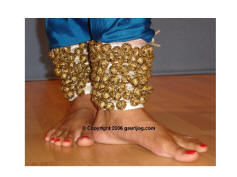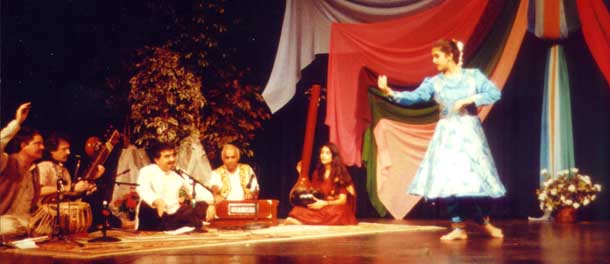Kathak is a major classical dance form of Northern India.

Kathak is a major classical dance form of Northern India. The word Kathak comes from the original Sanskrit word “Kathakar” which literally means a story teller. “Katha” means a story and Kathakar means a storyteller. “Katha kare so Kathakar”, which meant “one who tells a story is a storyteller”. Traditionally these story tellers were both men and women, a woman storyteller was known as “Kathika” and a male storyteller was “Kathaka”. These so called nomadic bards of ancient northern India, performed in village squares and temple courtyards, mostly specialized in recounting mythological and moral tales from the scriptures, and embellished their recitals with hand gestures and facial expressions. It was quintessential theatre, using instrumental and vocal music along with stylized gestures, to enliven the stories.
With the advent of Mughal culture, Kathak became a sophisticated chamber art. Under the patronage of medieval rulers and Nawabs a class of dancing girls and courtesans emerged to entertain the palaces and courts. Medieval traditions imparted Kathak a distinct Hindu-Muslim texture. Patronized by art loving rulers, the practitioners of Kathak worked at refining its dramatic and rhythmic aspects, delighting elite audiences with their mastery over rhythm and the stylized mime.
The technique of Kathak today is characterized by fast rhythmic footwork set to complex time cycles. The footwork is matched by the accompanying percussion instruments such as tabla and pakhawaj, and the dancer and percussionists often indulge in a virtuoso display of rhythmic wizardry. The dance movements include numerous pirouettes executed at lightning speed and ending in statuesque poses. The interpretative portion, based on tales of Radha and Krishna and other mythological lore, contains subtle gestures and facial expressions.
Lucknow, Banaras and Jaipur are recognized as the three schools, or gharanas, where this art was nurtured and where the interpretative and rhythmic aspects were refined to a high standard.

In the court of Wajid Ali Shah, the Nawab of Oudh (a student of Kathak), Kathak dance emphasized dramatic and sensuous expression and developed into a distinct style called the Lucknow Gharana. This Gharana is said to have originated with Wajid Ali Shah’s court dancer Thakur Prasadji. The Lucknow gharana developed a style of kathak that is characterized by precise, finely detailed movements and an emphasis on the exposition of thumri, a semiclassical style of love song. The Jaipur gharana required a mastery of complicated pure dance patterns. Nowadays, however, performers present a blend of kathak based on the styles of both gharanas.
A traditional Kathak performance features a solo dancer on a stage, surrounded on all sides by the audience. The repertoire includes amad (the dramatic entrance of the dancer on stage); thaat (a slow, graceful section); tukra, tora, and paran (improvised dance compositions); parhant (rhythmic light steps), and tatkar (footwork).

Kathak dance can be performed by both men and women. A Kathak dancer is not required strictly to stick to fixed steps and stages in. He or she can change the sequence of steps to suit his or her skill and style of dancing. Male dancers perform in Persian costume of wide skirts and round caps, while female dancers wear a traditional Indian garment called a churidar pyjama.
The narrative and poetic repertoire of Kathak continues to expand into the twenty-first century, including epics, devotional, romantic and mystical poetry in all the major languages of North India. Poetry written in Sanskrit, Urdu, Hindi and its dialects such as medieval Braj Bhasha and Avadhi reflects the mixed Hindu and Muslim roots of Kathak. The North Indian Hindustani style of classical music accompanies the dance, played by a musical ensemble that can include tabla and pakhawaj drums, sarangi, sitar, sarod, bamboo bansuri flute and vocalists.
Combining the spiritual fervor of the Hindu temple with opulent entertainment from the Moghul and Rajput courts, the Kathak dance tradition in the Twenty-first Century continues to evolve through the art of Kathak dancers in India and throughout the world. Enriched by contemporary literature, music and performance practice, Kathak responds to an increasingly global culture.
